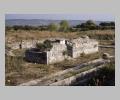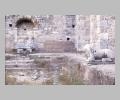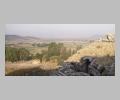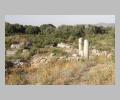| Summary: | A great maritime power, center of science and philosophy in the Archaic period, and a major port in later periods. |
| Type: | Fortified city and port |
| Region: | Ionia |
Periods:
Late Bronze Age
Archaic
Classical
Hellenistic
Roman
Physical:
The original topographical position of Miletus was on a peninsula at the S side of the opening to the Latmian Gulf. The natural harbors of the site gained additional shelter from the offshore island of Lade to the W. In contrast to Ephesus, Smyrna, and other Anatolian ports situated at the opening of broad valleys leading to the interior, Miletus had mountainous terrain at its back. The city was therefore more completely maritime in character and when silt deposited by the Maeander River closed the gulf and extended the shore line (today it is ca. 10 km beyond Miletus), the economy collapsed.
The early Archaic city of Miletus appears to have been centered around the temple of Athena, located between the southwestern Athena harbor and the central Theater harbor. After the Persian destruction in the beginning of the 5th century B.C. the city rebuilt and made extensive use of the grid system developed by the Milesian architect Hippodamos. The city center moved toward the NE, to the area between the base of the Lions harbor and E of the Theater harbor.
The remains of the Hellenistic and Roman city cover all of the flat area of the peninsula N of the Kalabak Tepe and were enclosed by a city wall completed in the 4th century B.C. The larger Athena and Theater harbors were backed by the city wall, but the narrower, more defendable Lion harbor allowed an opening in the city wall. This was sealed by a chain in time of danger.
In addition to the three W harbors at Miletus ships could also be landed on the east side of the city. The Lion harbor was the principal port of the city and was surrounded on three sides by quays, warehouses, and shops. At the S base of the Lion harbor is the North agora and the sanctuary of Apollo. Below the North agora is the South agora (the largest agora in the Greek world: 164 x 196 m) and the civic center of the city. Located here are the bouleuterion, major temples and hero shrines, the nymphaeum, and the starting point of the Didyma sacred way.
West of the South agora are the Baths of Faustina (the only structure not aligned to the city grid system) and the West gymnasium. Farther W, between the Athena and Theater harbors is the West agora, the latest of the city's three market places. The West agora is immediately N of the temple of Athena. North of the Theater harbor is the theater of Miletus, originally built in the 4th century B.C. and enlarged in the Hellenistic and Roman periods to a final capacity of 15,000 seats.
Description:
According to tradition, Miletus was first founded as a trading post by colonists from the Cretan city of Milatos sometime before 1400 B.C. The site appears to have passed into Mycenaean control and finally by the end of the Late Bronze Age into Carian hands. Miletus was the only Ionian city mentioned by Homer, who records that the Carian-led Miletians fought against the Greeks at Troy. Archaeological excavations at Kalabak Tepe, to the SW of the site, verify the early Minoan and Mycenaean presence.
The refounding of Miletus, early in the Iron Age, was traditionally credited to Neleus, a son of the legendary King Kodros of Athens. Neleus and the Ionian Greeks occupied the city, slaughtered the Carian males, and took the women as mates.
Because of its important maritime location and its proximity to the famous sanctuary of Apollo at Didyma, Miletus prospered as a trading center. During the 8th and 7th centuries B.C., Miletus established over 90 colonies throughout the E Aegean; from Naucratis in Egypt to Sinope on the Black Sea. The trade and international contacts of Miletus brought a prosperity and cosmopolitan character to the city. In the Archaic period Miletus was a major center for the early development of Greek science and philosophy. By the 6th century B.C. the city had grown in size and extended from the original site on Kalabak Tepe to the area of the harbor of the Lions. The city was renouned throughout the Greek world and was the most important of the 12 cities in the Panionian League.
Although Miletus seems to have had special privileges under Persian rule, it took an active part in the Ionian revolt of 500-494 B.C. Following the Greek defeat at the naval battle of Lade in 494 B.C., the Persians destroyed Miletus and killed or enslaved all the inhabitants. At the same time the sanctuary of Apollo at Didyma was also plundered and destroyed.
In 480 B.C. Greek victory over the Persians restored freedom to the Ionian cities. Miletus joined the Delian League and regained much of its former status. The previous prosperity of Miletus, however, had been based on its sea trade which was hindered by the rise of Athenian naval supremacy.
In 386 B.C. the Ionian cities again came under Persian control as a result of the Kings' Peace settlement. In 334 B.C., in the course of freeing the Ionian cities from Persian rule, Alexander the Great defeated the Persian garrison at Miletus. During the Hellenistic period Miletus passed under the control of a number of dynasties, finally being presented to the Romans by the last Attalid king.
Under Roman rule, Miletus had the status of a free city and continued to flourish until the 4th century A.D. when the silting of the Maeander delta closed the harbors and created a swamp at the former shore line. Miletus had always been predominately a maritime city and the loss of its harbors terminated the life of the city. In the Byzantine period a fortress was constructed on the upper ruins of the theater.
Exploration:
German excavations began at Miletus at the end of the 19th century and continue to the present.
Sources Used:
Other Bibliography:





